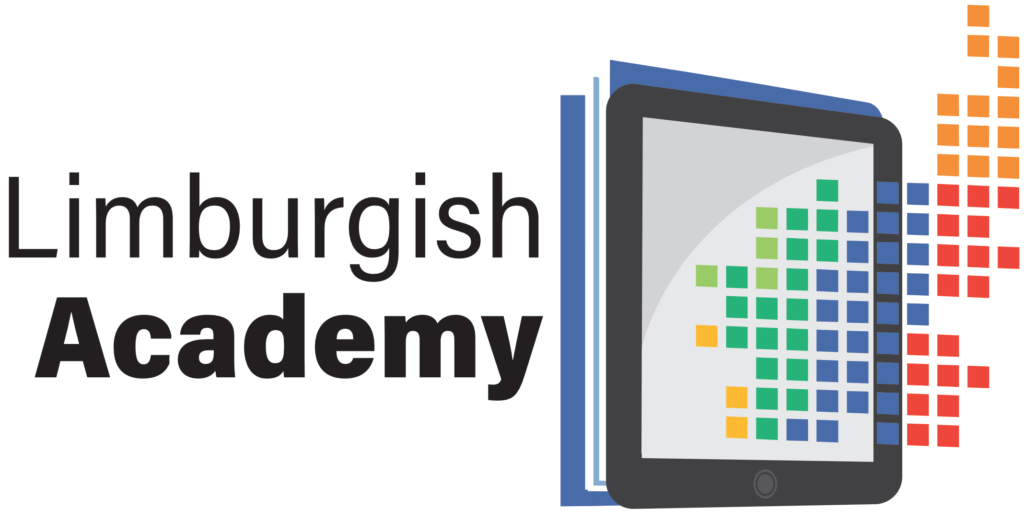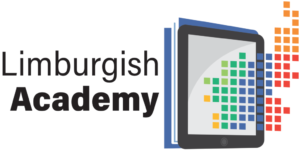Limburgish Language
noun /ˈlɪmˌbɜː(r)ɡɪʃ ˈlæŋgwɪdʒ/
the language spoken in and native to the Belgian and Dutch provinces of Limburg and some adjacent Rhineland territories. There are different varieties, often referred to by the name of the locality, such as Hessels, Kirchröadsj, Mestreechs, Remunjs, Tungers, Venloos, Zittesj, etcetera

Limburgish is a West Germanic language. Linguistically, Limburgish differs from the neighboring languages Dutch and German because of its contrastive tonality and its own phonology, grammar and vocabulary. Limburgish has its own written tradition and literature, partly dating back to the Middle Ages.
There are about 1.2 – 1.5 million speakers of Limburgish. Limburgish is used more in the Netherlands than in Belgium, with respect to age group, situation and socio-economic level. However, its use is decreasing and UNESCO has classified Limburgish as ‘vulnerable’.
In 1990 the Walloon government in Belgium declared Limburgish an indigenous regional language. In 1997, the Netherlands recognized Limburgish as a regional language under Part II of the European Charter for Regional or Minority Languages. The Council of Europe monitors whether the Netherlands complies with its Charter obligations. The Limburgish Academy has submitted an NGO report on this matter in 2019.
The Limburgish language
Characteristics
Limburgish is a West Germanic dialect situated between Dutch and German and is closely related to the neighboring Rhineland-German language area. Of all dialects and regional languages spoken in the Netherlands and Dutch-speaking Belgium, dialects of Limburgish are, according to some indexes, at the greatest linguistic distance from standard Dutch. The following features characterize almost every language utterance and strongly distinguish Limburgish from standard Dutch:
In terms of sound, it has experienced the High German consonant shift for a number of consonants, from plosive (k) to fricative (ch). Vowel structures often still correspond to the late medieval situation. Umlaut is used for diminutives, certain plurals and the 2nd / 3rd person of some strong verbs. Furthermore, Limburgish uses a contrastive tone accent (drag tone and push tone) to make a semantically functional distinction.
In terms of grammar and morphology, subordinate conjunctions are conjugated in dependent clauses if the subject of the sentence is the 2nd person singular or plural. Limburgish has its own personal pronouns. For auxiliary verbs, there is an irrealis-conjunctive. Limburgish has its own gerund form ending in a West Germanic relict form ‘-eere’ or ‘-erre’. Articles indicate the gender, masculine, feminine and neuter distinction of nouns. Furthermore, Limburgish frequently uses the reflexive pronoun ziech/zich ‘himself’ to express a benefactive object.
In terms of vocabulary, Limburgish is closely aligned with the Rhenish-German language area. Limburgish also preserves many words that are in disuse or extinct in standard Dutch. Furthermore, a large part of the Limburgish vocabulary is of Walloon origin. Lexically, Limburgish is separate from standard Dutch because common Limburgish words are not included in the lexicon of that standard language.
Contemporary presence
For East Limburg, it is estimated that 70-75 percent of a population of 1 million speaks Limburgish. That percentage is clearly higher in the elderly than the young. A large part of the 675,000 people in West Limburg have an active and passive command of Limburgish. The use of the language is decreasing. UNESCO, in the Atlas of the World’s Endangered Languages, has classified Limburgish as ‘vulnerable’.
In East Limburg, Limburgish is spoken by all socio-economic levels of society and in many more situations than on the Belgian side. In more formal situations, such as work or school (55 percent), at the doctor (40 percent) or on the phone with a stranger (20 percent), Limburgish is spoken. More than 80 percent of Limburgers speak the language with other speakers such as parents, friends, the hairdresser, the baker or butcher, with people on the street and when spoken to in Limburgish by people on the street or by a stranger. Between 60-80 percent speak Limburgish with their partner at home, with their partner in the presence of strangers and with their children.
In everyday contact with local and regional authorities, in the media and in healthcare, the language is often spoken in informal situations. Limburgish is used in church services for special holidays. Limburgish still has a strong presence in cultural life: carnival, pop music, plays and literature. The language is also one of the most studied regional languages and the subject of many lexicographic studies. Limburgish is also regularly used in social media, more than other regional languages in the Netherlands.
Historical presence
Old Limburgish
In the eighth and ninth centuries, the predecessor of Limburgish was spoken by most people in Meuseland territories in the Low Countries. Latin was the language of government and science as well as the Church. Nevertheless, there were some openings for the vernacular in the church: the vernacular was allowed for the Lord’s Prayer, the creed and the sermon.
Middle Limburgish
From the thirteenth century on, a Middle Limburgish that differed locally came into use as an official language for government documents such as certificates, gifts of purchase or leases, judgments, and wills. There are extensive property registers from Aldenbiesen from 1280. In Tongeren from 1277 onwards charters were written in the vernacular. A charter from Sittard in 1243 shows that Limburgish was already used as the official language at that time. From Maastricht the Statutebook of Maastricht of 1380 and charters are known. Archival documents from the 15th and 16th centuries in Heerlen also point to the use of Middle Limburgish as a language of government.
New Limburgish
The Meuse-Rhineland region was already fragmented politically in the Middle Ages and was divided even further from 1600 due to raids from neighboring countries. The new rulers introduced their languages for administration and justice in their Limburgish territories. Depending on the occupying power, French, Dutch or High German were used as languages of government.
During the French period from 1794 to 1814 civil justice in the Limburgish territories was only allowed to take place in French. Official documents also had to be written in French from 1803 onwards. French was introduced in primary education.
In 1814, the Dutch appropriated dominion over Limburg. King Willem I imposed Dutch as an official language and as a subject and medium of instruction in all education. In West Limburg, after the separation of Belgium in 1830, French was first reintroduced as a language of government, justice and education. Under the influence of the Flemish Movement, Dutch was reintroduced in an increasing number of situations from the end of the 19th century, also as a language of government and in education.
At the end of the First World War, Limburgish was the language spoken in everyday life. Dutch was the official written language, the language of government and education because of the politics of Dutchification. Especially in East Limburg, written Limburgish was used quite often for special cultural events.
Legal status
By decree of 24 December 1990, the Walloon federal government in Belgium was the first to recognize Limburgish spoken in Belgium as a regional indigenous language. Legal and political recognition in the Netherlands followed when in 1997 the Dutch government recognized Limburgish for East Limburg as a regional language under Title II of the European Charter for Regional and Minority Languages.
Under the provisions of the Charter, Limburgish is not a dialect of Dutch, but a separate regional language. The Dutch State is obliged under international law to fulfill its obligations under the Charter. So far, the Dutch government has failed to implemented its Charter obligations. In 2019, the Limburgish Academy submitted an NGO report (in English) to the Council of Europe, which monitors compliance with the Charter.
At the end of 2019, Limburgish received a political-administrative recognition as a separate language. With the Convenant inzake de Nederlandse erkenning van de Limburgse taal (‘Covenant regarding the Dutch recognition of the Limburgish language’), the Ministry of the Interior in The Hague and the Province of Limburg have agreed to develop a language policy for Limburgish. An analysis by the Limburgish Academy (in Dutch) explains what this means and how the recognitions under the Charter and the Covenant relate to one another.


